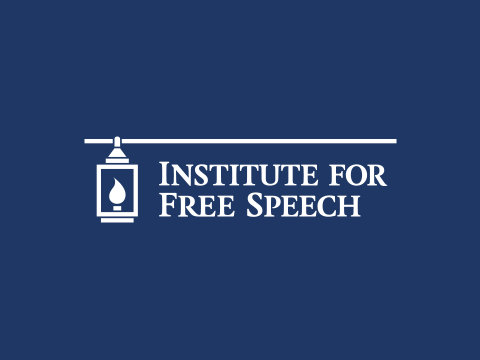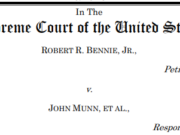Vox.com’s “40 charts that explain money in politics” fails miserably at, well, explaining money in politics. The charts seem to be less an explanation and more unproven innuendo about why money is supposedly ruining American democracy. What the collection of charts does do, however, is provide a window into some of the common misconceptions about campaign donations, campaign donors, and their supposed pernicious effects on elected officials. Here are 15 things that Vox should have mentioned to really explain money in politics.
Part II covers disclosure, independent groups, state-level campaign finance laws, and various other topics. Check out Part I, covering campaigns and donors, here.
6) The vast majority of campaign donations are disclosed.
In Charts 18 and 19, Vox “explains” that “outside spending” (that is, money spent by independent groups) and “dark money” (that is undisclosed spending) are soaring. Leaving aside the problem mentioned in item #1 above about comparing data from OpenSecrets pre- and post-2010 (when they shifted methodologies for counting so-called “outside spending”), the Vox charts fail to offer any perspective on the scope of these supposed threats.
So-called “dark money” accounted for just over 4 percent of all money spent in the 2012 election cycle. That might be a surprising figure considering statements like, “an incredible amount of this new outside money spending is coming from groups that don’t disclose their donors.”
When Vox adds, “[a]nd we’ll likely never know where most of this money came from,” they probably should have looked at their own next chart for the answer, as chart 20 is titled, “These are the top dark money groups of 2012.” This further undercuts the idea that there is a flood of secret money coming into our elections. The names of the highest spending groups and their motivations are well known. It includes such “secret groups” as Karl Rove’s Crossroads GPS (run, I am guessing, by Karl Rove), the environmental organization, the League of Conservation Voters, and the pro-business U.S. Chamber of Commerce. In fact, a quick Google search of any organization on the list in Chart 20 will tell you exactly who they are and what ideas they support.
One can disagree with these groups’ ideologies or policy preferences, precisely because their positions are well-known. This is not the shadowy underworld conjured up by the phrase “dark money”; this is democracy.
7) Much “outside spending” is from political insiders.
Furthermore, this so-called “outside spending,” is coming from well-known sources. Vox chart 18 tells us that, “[m]ore and more, our elections are influenced by big-spending individuals or groups that operate outside of traditional political party roles.” But a closer look at the data suggests that this is simply not the case. Once again, “outside spending” has only been tracked in detail by OpenSecrets since 2010, so the apparently dramatic increase is likely overstated.
Even putting data-tracking issues aside, much of today’s independent spending is simply the result of a legal reorganization of existing powers in response to the gobs of campaign finance regulations already on the books. Far from “operating outside traditional party roles,” much “outside spending” is party spending that has simply taken on a different legal status.
Don’t believe me? Here is the list of the top “outside groups” in 2012. Five of the top eleven are direct party affiliates – the National Republican Congressional Committee, the Democratic Congressional Campaign Committee, their Senate counterparts, and the Republican National Committee itself. Three others are Super PACs that were organized to support particular well-known candidates (the pro-Mitt Romney Super PAC “Restore our Future,” the pro-President Obama Super PAC “Priorities USA Action,” and Senate Majority Leader Harry Reid’s Super PAC dedicated to retaining a Democratic Senate majority cleverly named, “Senate Majority PAC” – currently the biggest spender in the 2014 election cycle). This complaint really boils down to unhappiness by some with one group, Karl Rove’s American Crossroads, the biggest independent spender in 2012. One very well-funded, but largely unsuccessful independent spender does not, however, mean “outside groups” are influencing elections more and more, as Vox insinuates.
It is true that the party structure that was so powerful in the 1960s has lost much of that power in this new legal framework. But it has been replaced with a new structure, run by many of the same party loyalists. We shouldn’t pretend there is a new sheriff in campaign politics – the old sheriff just formed a Super PAC.
8) It is not controversial to argue that campaign spending is speech.
Vox Chart 16 attempts to show four decades of a starkly divided Supreme Court, striking down all of Congress’s “reasonable” campaign regulations, in the name of “the First Amendment.” But, in the seminal and most important case in the world of campaign finance, Buckley v. Valeo, that is not the case, and Vox’s chart is simply wrong. Only one of the eight justices presiding in that case (Justice Byron White) actually thought that all campaign expenditures could be capped by Congress. The other seven saw serious problems with campaign regulations limiting speech. That includes the partial dissent from the liberal stalwart, Justice Thurgood Marshall, who concurred in all parts with the majority opinion with the exception of caps on the use of a candidate’s personal fortunes.
This near-unanimity, including from liberal jurists, is important to understand because all future Court decisions are predicated not on whether election spending is speech but on how far congress can go to restrict that speech. So, in Citizens United, the argument was can Congress ban a movie because it was funded by corporate dollars and mentioned a candidate in a certain time frame before an election? It was not, as Vox egregiously misstates, a question of whether “corporations can spend directly on campaigns.” The federal ban on corporate donations to campaigns is still the law of the land.
When the court strikes down campaign finance regulations “in the name of free speech,” it is not some legal fiction – almost all legal scholars agree that the cases are about speech; some judges simply believe those speech restrictions are justified.
9) State campaign contribution limits on individual giving to legislative candidates have no effect on the quality of a state’s governance.
In Chart 35, Vox correctly points out that contribution limits vary widely from state to state. It might be helpful, however, if one is attempting to explain “the role of money in politics,” to look at how this actually effects state government. We could, for instance, compare the 50 states to test the efficacy of campaign contribution limit laws and determine if they are worth the restrictions they impose on political speech.
It turns out such limits have no effect (or a slightly negative effect) on the quality of a state’s governance. If you compare state contribution limits to at least one reputable study of “good government” (as we did here), you find that states with no or high campaign contribution limits rate slightly better than states with strict donation limits. In fact, seven of the top eleven best-governed states have no limits on individual giving to legislative candidates.
Here is the full chart, in case Vox wants to include it next time they “explain” money in politics (Green shading represents no or high limit states, yellow indicates states with moderate limits, and red states have strict limits on individual giving to state candidates).
10) State contributions limits on individual giving to candidates have no effect on a state’s public corruption rate.
Of course, some argue that contribution limits are not meant to produce effective government per se (contrary to the statements of advocates of such limits), but are actually intended to stop political corruption. It turns out, however, that there is no correlation between corruption and limits on individual giving either. (Academic research offers further proof of this point.) In what would have to be a surprise to anyone listening to the charged rhetoric in the media, four of the ten least corrupt states (Oregon, Nebraska, Utah, and Iowa) allow unlimited contributions from individuals to state candidates.
A few more lessons about “money in politics” that Vox forgot to mention, in rapid fire-fashion:
11) Lobbying expenditures are not equivalent to campaign contributions.
It’s like comparing apples and pineapples. They sound like they’re related, but anyone looking at them could not possibly confuse the two.
12) Politicians spend significant chunks of time fundraising because contribution limits, both federally and in many states, are extremely low and have failed to keep pace with inflation.
If you think the time politicians spend fundraising is a serious problem, you could advocate for the elimination of contribution limits.
13) If a study finds that the most “ethical state” is New Jersey, ignore that study immediately.
Seriously.
14) President Obama gets most of his money from California, New York, and Illinois because those are the states with the most registered Democrats.
So, we can’t be too surprised that many wealthy Democrats live there too.
And finally…
15) When you are trying to explain every aspect of the sweeping category “money in politics,” you probably need more than 40 charts.
Of course, striving to actually accurately explain the subject matter doesn’t hurt either.














